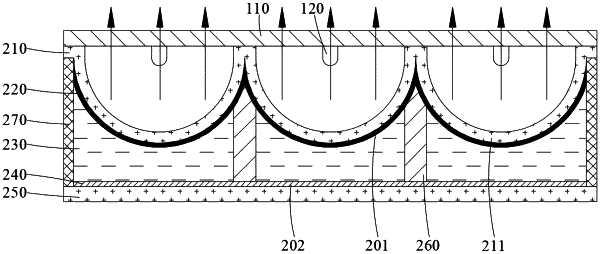| CPC H01L 25/0753 (2013.01) [G02F 1/133603 (2013.01); G02F 1/133604 (2013.01); H01L 25/167 (2013.01); H01L 33/405 (2013.01)] | 19 Claims |

|
1. A backlight circuit, comprising a lamp panel, the lamp panel comprising a driving substrate and a plurality of light-emitting chips, and the plurality of light-emitting chips being disposed on one side of the driving substrate at intervals, wherein the backlight circuit further comprises a plurality of electron microscope assemblies, the plurality of electron microscope assemblies being disposed on light-emitting sides of the plurality of light-emitting chips in a one-to-one correspondence manner;
wherein the plurality of electron microscope assemblies comprise transparent electrode shields, electrolytes and electrode plates, the transparent electrode shields being disposed on a first side of the driving substrate and being a cup-shaped structure that converge, after forming a reflective film on a surface, divergent light emitted from the plurality of light-emitting chips, the plurality of light-emitting chips being positioned in the transparent electrode shields, the electrode plates being disposed on sides, away from the driving substrate, of the transparent electrode shields, the electrolytes being filled between the transparent electrode shields and the electrode plates, and the electrolytes containing metal ions;
wherein first electric fields or second electric fields are capable of being formed between the transparent electrode shields and the electrode plates, and directions of the first electric fields are opposite to those of the second electric fields;
wherein under an action of the first electric fields, the metal ions of the electrolytes are capable of forming first metal reflective films on surfaces of the electrode plates, and the divergent light emitted from the plurality of light-emitting chips passes through the transparent electrode shield and the electrolytes and is reflected by the first metal reflective films, such that the divergent light is emitted through the transparent electrode shield and the electrolytes toward the driving substrate; and
under an action of the second electric fields, the metal ions of the electrolytes are capable of forming second metal reflective films on surfaces of the transparent electrode shields, and the divergent light emitted from the plurality of light-emitting chips passes through the transparent electrode shield and is reflected and converged by the second metal reflective films, such that parallel collimated light is emitted through the transparent electrode shield toward the driving substrate.
|